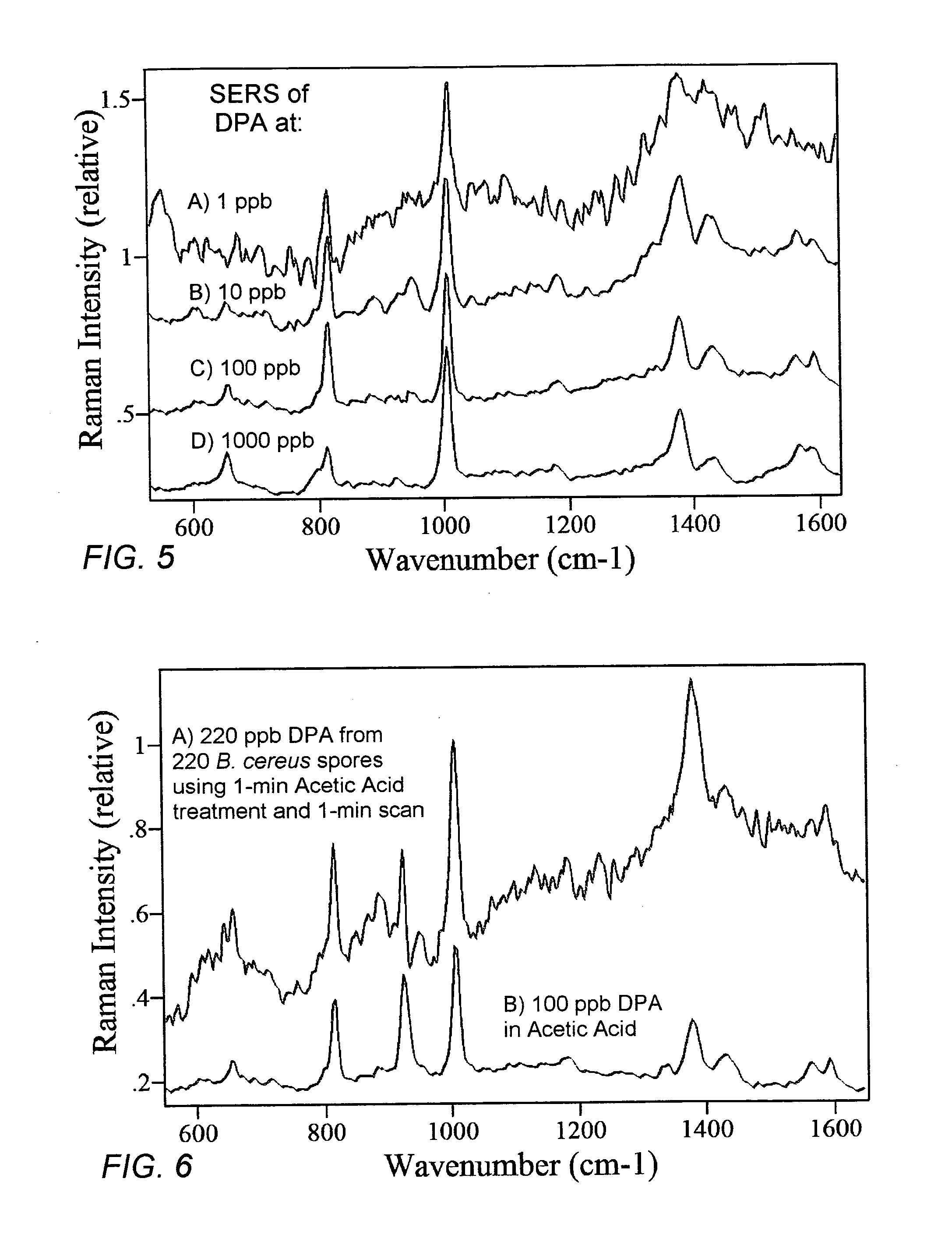Method for effecting the rapid release of a signature chemical from bacterial endospores, and for detection thereof
a technology of signature chemical and endospore, which is applied in the field of rapid release of signature chemical from bacterial endospore, and detection thereof, and can solve the problems of difficult determination of low spore concentration, significant time-consuming due to sample handling and data analysis, and insufficient unique emission spectrum to differentiate it from common biological materials
- Summary
- Abstract
- Description
- Claims
- Application Information
AI Technical Summary
Benefits of technology
Problems solved by technology
Method used
Image
Examples
example 1
Analysis of a Mail Sorter for Anthrax-Causing Endospores
[0092] An envelope containing 1 g of Bacillus anthracis spores is passed through a mail sorting machine, hypothetically leaving behind an average of 100 picograms, or 10 spores per cm2 (invisible to the unaided eye), on the equipment surfaces 1. With reference to FIG. 1, 50 microL of glacial acetic acid is dispensed onto the surface, which spreads over a 100 cm2 circular area of the machine. During the course of 1 minute, the acetic acid effects the release of CaDPA from the estimated 1000 spores, producing from 0.5 to 1.5 nanograms of DPA in the solution. A 1 mL syringe 5 is used to draw 10 microliters of the acetic acid solution 6, containing on average 0.2 ng of DPA, through a PTFE filter 7 into a 1-mm diameter glass capillary containing a SERS-active sol-gel 10. The capillary is then mounted in the sample holder of a Raman spectrometer 11, and 85 mW of 785 nm laser excitation radiation is focused into the silver-doped sol-...
example 2
Continuous Analysis of Air to Detect B. anthracis Endospores
[0093] A container of B. anthracis endospores is opened and left in the lobby of a commercial building, causing the release of 20,000 spores per cubic meter of air. Ambient air is drawn into a return duct of the building ventilation system, and is passed, at the rate of one cubic meter per minute, through a large-particle filter or large-particle cyclone-separator, and (with reference to FIG. 12) into a cyclone unit 35. The cyclone is designed to retain particles of 1-5 micron in collector 37 while passing particulate matter of finer sizes. A thin film of acetic acid is caused to flow from the reservoir 36 over the inner, lower portion of the conical enclosure of the cyclone, thereby collecting 50 percent of the deposited particles; air is passed through the cyclone at the rate of one cubic meter per minute, and acetic acid is collected at the rate of 50 mL per minute. A pump 38, and appropriate valves (not shown), are use...
example 3
Analysis of Hospital Air for Clostridia Endospores
[0095]Clostridia are one of the most common bacterial causes of food-borne illnesses (Clostridium perfengens), including botulism (Clostridium botulinum). They also cause tetanus (Clostridium tetani), pseudomembranous colitis, and anti-biotic associated diarrhea, the latter being the most frequently identified cause of hospital-acquired diarrhea (Clostridium defficile). For example, see McDonald L C, M Owings, D B Jernigan, “Increasing Rates of Clostridium difficile Infection Among Patients Discharged from US Short-Stay Hospitals, 1996-2003”, Emerg Infect Dis, 12, 1-20, 2006.
[0096] Similar to the previous Example, the ambient air is drawn into a return duct of a hospital ventilation system, and is passed, at the rate of one cubic meter per minute, through a multi-stage impactor that captures particles of decreasing size range as it passes through each stage, until finally, particles of 1-5 micron are deposited into numerous vials r...
PUM
| Property | Measurement | Unit |
|---|---|---|
| Fraction | aaaaa | aaaaa |
| Fraction | aaaaa | aaaaa |
| Time | aaaaa | aaaaa |
Abstract
Description
Claims
Application Information
 Login to View More
Login to View More - R&D
- Intellectual Property
- Life Sciences
- Materials
- Tech Scout
- Unparalleled Data Quality
- Higher Quality Content
- 60% Fewer Hallucinations
Browse by: Latest US Patents, China's latest patents, Technical Efficacy Thesaurus, Application Domain, Technology Topic, Popular Technical Reports.
© 2025 PatSnap. All rights reserved.Legal|Privacy policy|Modern Slavery Act Transparency Statement|Sitemap|About US| Contact US: help@patsnap.com



